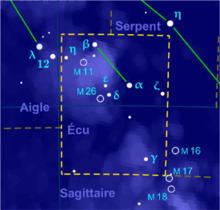Magnitude 4.72 Apparent magnitude (V) 4.72 | Constellation Scutum | |
 | ||
Similar UY Scuti, Alpha Scuti, Beta Cassiopeiae, S Doradus, NGC 6712 | ||
Delta scuti stars extra footage
Delta Scuti (δ Sct, δ Scuti) is a giant star in the southern constellation Scutum. With an apparent visual magnitude of 4.72, it is the fifth-brightest star in this small and otherwise undistinguished constellation. Analysis of the parallax measurements made during the Hipparcos mission place this star at a distance of about 202 light-years (62 parsecs) from Earth. Delta Scuti is the prototype of the Delta Scuti type variable stars. It is a high-amplitude δ Scuti type pulsator with light variations of about 0.15 minutes. The peculiar chemical abundances of this star are similar to those of Am stars.
Contents
In 1900, William W. Campbell and William H. Wright used the Mills spectrograph at the Lick Observatory to determine that this star has a variable radial velocity. The 6999193770000000000♠0.19377-day period of this variability as well as 0.2 magnitude changes in luminosity demonstrated in 1935 that the variability was intrinsic, rather than being the result of a spectroscopic binary. In 1938, a secondary period was discovered and a pulsation theory was proposed to model the variation. Since then, observation of Delta Scuti has shown that it pulsates in multiple discrete radial and non-radial modes. The strongest mode has a frequency of 59.731 μHz, the next strongest has a frequency of 61.936 μHz, and so forth, with a total of eight different frequency modes now modeled.
The space velocity components of this star in the galactic coordinate system are [U, V, W] = [–42, –17, –1] km·s−1. It is following an orbit through the Milky Way galaxy that has an eccentricity of 0.11, carrying it as close as 22.31 kly (6.84 kpc) to, and as far as 27.59 kly (8.46 kpc) from the galactic center. If Delta Scuti maintains its current movement and brightness, it will pass within 10 light-years of the solar system, becoming the brightest star in the sky between 7006115000000000000♠1150000 and 7006133000000000000♠1330000 CE. It will reach an apparent magnitude of -1.84, brighter than the current -1.46 of Sirius.
This star has two optical companions. The first is a +12.2 magnitude star located is 15.2 arcseconds from Delta Scuti. The second is a +9.2 magnitude star that is 53 arcseconds away.
Flamsteed did not recognise the constellation Scutum and included several of its stars in Aquila. δ Scuti was catalogued as 2 Aquilae. The Bayer designation δ was assigned by Gould rather than Bayer.
